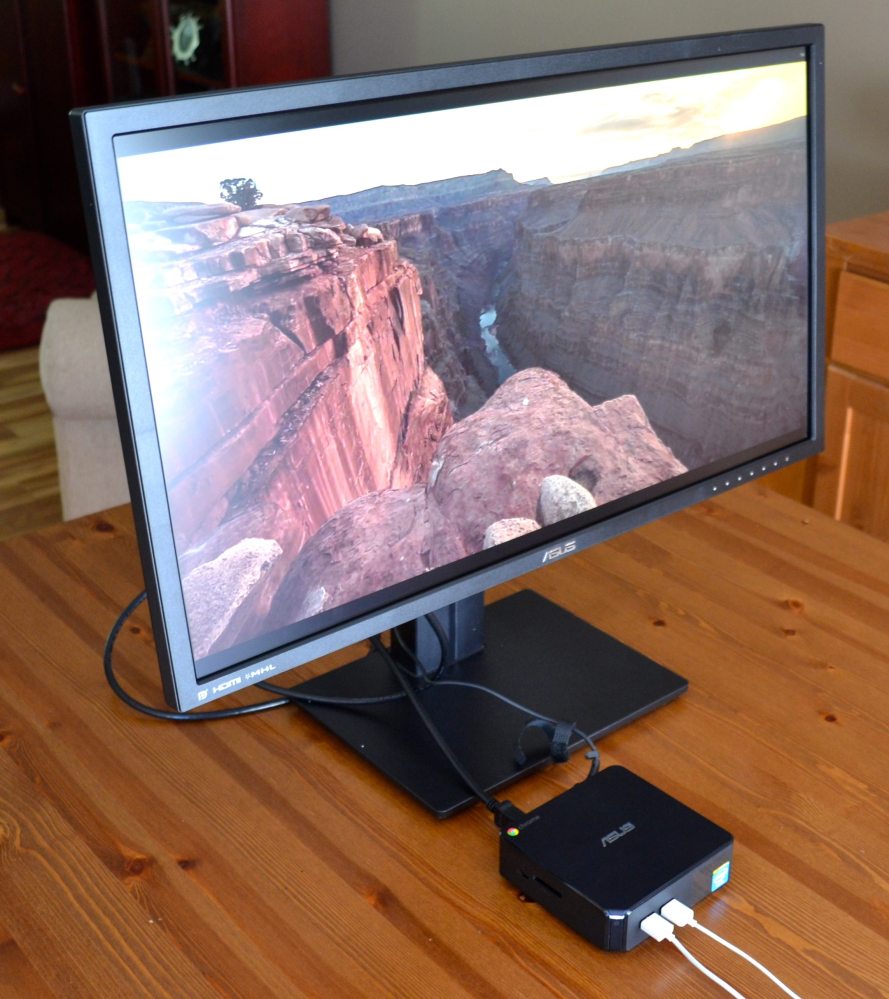
I frequently have some odd gear show up at the house in search of a review. An iPhone case that doubles as a bottle opener, an MP3 player from a power tool company — that kind of thing. I had one of the more unusual pairings in recent memory show up this week. A Chromebox together with a 28-inch 4K UHD monitor. Either on its own is nothing that strange, but having Asus send a Chromebox (about the cheapest PC you can buy) along with a rather pricey, big, Ultra HD monitor stuck me as kind of amusing.
Asus bills its Chromebox as the “smallest Chrome device” on the market. At 4.88-inches square and 1.65-inches tall, it certainly looks the part.
I won’t get into the whole Chrome vs. Windows or OSX experience, but the Chromebox did as well as any of the Chromebooks I’ve used. It’s powered by a 1.4 GHz Celeron CPU with 2GB of RAM and a 16 GB SSD. Performance was fine for what it is.
The surprising thing is that the Chromebox has the ability to drive a 4K monitor at full resolution. Which is where the Asus PB287Q comes in.
The monitor is a pretty large one, a tad bigger than the 27-inch iMac I usually use as a display, but it has the advantage of being able to pivot 90%. Oh, and it has a resolution of 3840 x 2160, or nearly 8 million pixels.
That makes for a very, very crisp picture, at least when you show 4K source material.
Hooked up to the Chromebox, the result is somewhat mixed. 4K still pictures look incredible. 4K video looks incredible at times, but that’s where the Chromebox’s graphics limitations come into play. Even when a 4K video was fully cached, it would sometimes get glitchy, the picture would freeze for a few seconds or the audio would go out of sync. But when you closed down the extra open Chrome tabs and everything hummed, that 4K video sure looked pretty.
I set the monitor up about three feet from me and at native resolution I could hardly read a word of the text onscreen, it was so tiny. That’s not just bad eyesight. The amount of screen real estate is almost comical, and you can sure fit a heck of a lot of Chrome tabs across that many pixels. Mind you, things will soon come to a crawl — this is a Chromebox after all, and one that’s not maxed out on RAM — but if you like to have lots of open windows, a 4K monitor is nice.
If you want to try out the whole Chrome OS thing and don’t want to pay for a Chromebook, you can pick up an Asus Chromebox for around $170 (you can use an old PC monitor instead of forking out for a 4K one so long as it supports HDMI). If you want the version that includes the Chrome-optimized Bluetooth keyboard and mouse, or a more powerful CPU (Core i3 and Core i7 are optional), the price goes up from there. RAM is user-upgradable but maxes out at 4GB.
Update: After being asked to check on that maximum RAM by James, I verified the published specs with Asus: “2 GB Up to 4 GB Dual Channel, DDR3 at 1600MHz,” but have found reports online of people who are successfully running this Chromebox with 8GB of RAM.
The Asus 4K monitor was a thing of beauty in terms of picture. Ultra HD (enough said), low reflection and it has a 1ms response time that should work well for gamers. Pivoting capability is great too, especially if you work on documents and could make use of portrait orientation. It came with a DisplayPort cable (also supported by the Chromebox), and offers HDMI as well.
I didn’t care much for the cable management, it was lacking in ports (no USB pass-through for example) and the physical adjustments were a little imprecise, so it was easy for the display to end up looking crooked. But this a good-sized 4K monitor (with Picture in Picture capability) that’s going for under $700, so the shortcomings seem like a reasonable trade-off.
Of course, that judgement would depend on how you plan to use it.
So, each good in its own way, but I still think the combo of the little Chromebox that will fit in my hand and the 4K monitor is funny…



As you sure about the max RAM?
Good catch, James. Asus says “2 GB Up to 4 GB
Dual Channel, DDR3 at 1600MHz” but it looks as though people have been successful with 8GB. I’ll update the info to reflect that. Thanks, Brad.
I hooked mine to a 1600 x 900 Acer monitor using a Displayport to DVI-D adapter and it works nice and sharp!
I have my Chromebox hooked up to a 27″ Asus It’s monitor via hdmi and get full resolution. It’s a great combination. I have mounted to the back of the monitor out of sight and it works beautifully.
When I need more horse power or use of Windows software I use Chrome RDP to connect to a Dell 8100 running win 7. I love the setup.